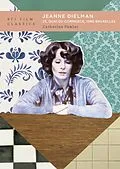"Lucid, lively and extremely knowledgeable." Sight & Sound
Catherine Fowler's study positions Jeanne Dielman as a 'contrary' classic, its contrariness arising from director Chantal
Akerman's decision to frame an unliberated housewife through a kind of 'slow looking'. By choosing to stay with Jeanne in the kitchen, the film both 'differences' the canon and diverges from Akerman's liberated early films, which involved the rejection of domestic space, married life and the heterosexual script.
Fowler draws on original footage, scripts, unmade and unseen projects, interviews and other documents to painstakingly piece together the making of the film, discovering an alternative origin story which centers upon female alliances, forged through a combination of shared film culture and lived sexism. Those viewers who take up Akerman's invitation to spend time with Jeanne will find their expectations of cinema are changed. Because more than any other film before or since, it reminds us that we give our time to a film; and in making us look both harder and for longer it asks us to feel time slipping away, for ourselves as much as for its protagonist.
Autorentext
Dr Catherine Fowler is the Associate Professor in Film at the University of Otago, New Zealand. She has been a student of Chantal Akerman's cinema for some twenty five years, having written her PhD on Akerman's 'cinema of displacements' and published aspects of it in various edited collections. Her most recent book on British film-maker Sally Potter, published 2008, offers the first book length survey of a director who uses song, dance, performance and poetry to expand our experience of cinema beyond the audiovisual.
Klappentext
Chantal Akerman's 1975 film Jeanne Dielman portrays in excruciating detail and in real time the daily life of a single mother, as she cooks, cleans and cares for her son, and has sex with male clients in her home. Akerman, who shot the film in five weeks with an all-female crew, described Jeanne Dielman as a challenge to 'a hierarchy of images' that places a car accident or a kiss 'higher in the hierarchy than washing up ... And it's not by accident, but relates to the place of woman in the social hierarchy ... Woman's work comes out of oppression and whatever comes out of oppression is more interesting.'
Yet Jeanne Dielman's importance is broader and more sustained than the originality of its subject matter and form. More than any other film before or since, it reminds the viewer that we give our time to a film; and in making us look both harder and for longer it asks us to feel time slipping away, for its protagonist as much as for ourselves.
Catherine Fowler's study of the film articulates the fascination of Jeanne Dielman over and above its place as an exemplary film to watch and study. She provides a close textual analysis of performance, particularly that of Delphine Seyrig as the title character, mise-en-scène, narrative structure, camerawork and editing, and draws on original footage, interviews and documents to explore the making of the film. She interrogates its unique representation of domestic space and the materiality of women's time. In doing so, she illuminates why the film is seen as a significant precursor for what came to be known as 'Slow Cinema' and why it continues to exact such significance in film history today.
Inhalt
Acknowledgments
1. Looking Back - The making of a myth
2. Looking Harder - Jeanne Dielman, housewife
3. The Look of Jeanne - on Delphine Seyrig
4. Looking Longer - Slowness and the Cinema
5. Looking Now - Jeanne Dielman today
Credits
Bibliography
